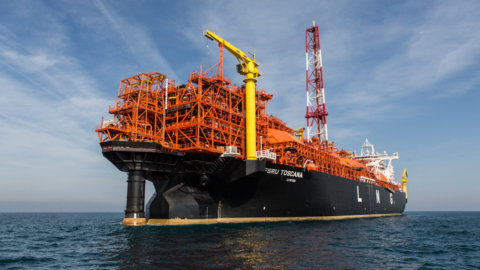La Golar Tundra has arrived at Piombino, positioned at the dock of the North Dock. The much discussed regasifier ship entered the Tuscan port during the night between Sunday 19 and Monday 20 March, chosen to host the infrastructure for the next three years. This is the first of the two ships purchased about a year ago, on a mandate from the Draghi government, by the Snam group - the company that manages large infrastructures for the transport and supply of gas - to ensure the arrival of new methane flows useful for securing the coming winters. But what is the Piombino regasification ship for and how it works?
The Piombino regasification terminal – at the center of many threads in recent months and much contested by the local population – as well as the BW Singapore di Ravenna (in Emilia-Romagna) will free Italy from a significant share of methane import dependency from onshore pipelines. Managers will be able to turn to the markets of other continents (Africa, America, Asia and Oceania) and thus remedy the geopolitical turbulence that can affect the transport of gas only by land, as we have seen in recent months. With the other Fsru of Ravenna it will contribute to 13% of the national energy demand.
Golar Tundra is approximately 292 meters long, approximately 43 meters wide and approximately 55 meters high (maximum height from keel to highest point). According to Snam data, the ship is equipped with four storage tanks liquefied natural gas (LNG), arranged in the central part of the hull, has the regasification plant forward, while the crew quarters, centralized control room and service machinery are located aft. Built in 2015, the vessel has a storage capacity of around 170 cubic meters of liquefied natural gas and a continuous regasification capacity of 5 billion cubic meters a year (6,5% of national demand).
How does the Piombino regasification ship work?
The Golar Tundra can operate both as an LNG carrier and as a LNG tanker Fsru. The Fsru, "floating storage and regasification unit" (or floating storage and regasification unit), store the liquefied natural gas supplied by tankers and regasify it for subsequent use on land.
The Piombino regasification terminal will be replenished at regular intervals from LNG carriers. Once near the FSRU, the LNG tanker carrying the LNG (at a temperature of -160°C) transfers it to the tanks of the terminal. This process takes place via unloading arms installed on the Fsru. These extend and hook up to the flanges of the LNG carrier, at which point the LNG is decanted into the tanks and stored. And subsequently it is regasified. The regasification process it is obtained by introducing the LNG into a heat exchanger in which a hotter liquid flows, normally sea water, whose natural temperature is sufficient to return the gas to its gaseous state. The ambient temperature methane obtained from the regasification process is then compressed and fed into a gas pipeline that starts from the Fsru and reaches the national transport network.
Why Piombino?
The choice of Piombino is not accidental. According to various insights, the Tuscan locality is the only one able to ensure, for technical reasons, the entry into operation of the terminal in times compatible with the current energy crisis. the regasification terminal will remain in the port of Piombino for 3 years, then as explained by Massimo Derchi (Chief Industrial Assets Officer of Snam) have verified the feasibility of a site in the Adriatic and are about to verify the feasibility of another site in the Adriatic and Upper Tyrrhenian Sea, outside Tuscany.
When will the Piombino regasification ship come into operation?
According to what was also reiterated in recent days by the CEO of Snam Venier, the first gas should arrive at Half may. By the first half of April, the regasifier ship will be connected to the pipeline with the national gas network, while the arrival of the first load is expected between the end of April and mid-June.
Why are many against it?
Over the months there have been many manifestations public against the Golar Tundra. But as they have observed the judges of the Lazio Administrative Court "the process that led to the adoption of the burdened provision did not give evidence of obvious anomalies in the development of the procedure". Snam has also repeatedly reiterated the safety for the community, as no chemical processes will be carried out on the ship but only operations functional to the phase change of the LNG through vaporization. The Golar Tundra has compliance certifications in line with the main applicable regulations and equipped with all necessary fire and safety systems. All risk analyzes were submitted, in accordance with the provisions of current legislation, to the competent safety authorities. The terminal is in any case equipped with process control and safety block systems and capable of guaranteeing, among other things, the detection of any natural gas leaks, the detection of any fires and the activation of the essential parameters for maintaining the terminal in safe condition.
The investment supported by Snam
The company led by Venier bought the Golar Tundra regasification vessel last June from Golar Lng Limited for 350 million dollars (about 330 million euros). The investment of the entire project is worth 100 million euros. Overall, Snam's outlay is around 450 million.
How many regasification terminals are there in Italy?
The Piombino and Ravenna regasification terminals will join three others already active in Italy. The largest is the Adriatic LNG terminal (offshore plant): an artificial island located in the sea off Porto Viro, in the province of Rovigo, and has an annual production capacity of 8 billion cubic meters of gas.





